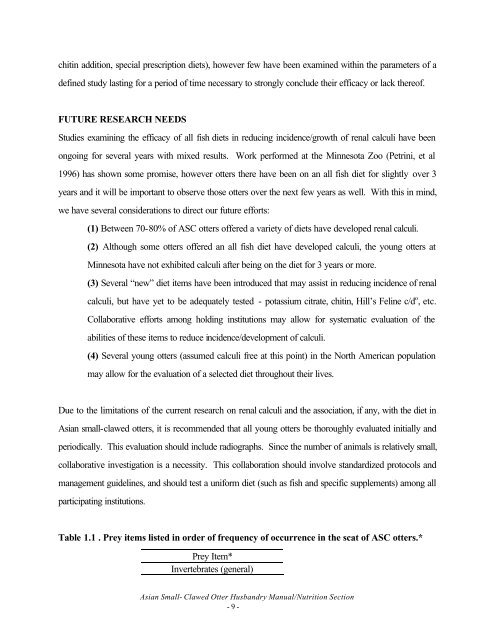Asian Small-Clawed Otter Husbandry Manual (1998)
Asian Small-Clawed Otter Husbandry Manual (1998)
Asian Small-Clawed Otter Husbandry Manual (1998)
Create successful ePaper yourself
Turn your PDF publications into a flip-book with our unique Google optimized e-Paper software.
chitin addition, special prescription diets), however few have been examined within the parameters of adefined study lasting for a period of time necessary to strongly conclude their efficacy or lack thereof.FUTURE RESEARCH NEEDSStudies examining the efficacy of all fish diets in reducing incidence/growth of renal calculi have beenongoing for several years with mixed results. Work performed at the Minnesota Zoo (Petrini, et al1996) has shown some promise, however otters there have been on an all fish diet for slightly over 3years and it will be important to observe those otters over the next few years as well. With this in mind,we have several considerations to direct our future efforts:(1) Between 70-80% of ASC otters offered a variety of diets have developed renal calculi.(2) Although some otters offered an all fish diet have developed calculi, the young otters atMinnesota have not exhibited calculi after being on the diet for 3 years or more.(3) Several “new” diet items have been introduced that may assist in reducing incidence of renalcalculi, but have yet to be adequately tested - potassium citrate, chitin, Hill’s Feline c/d o , etc.Collaborative efforts among holding institutions may allow for systematic evaluation of theabilities of these items to reduce incidence/development of calculi.(4) Several young otters (assumed calculi free at this point) in the North American populationmay allow for the evaluation of a selected diet throughout their lives.Due to the limitations of the current research on renal calculi and the association, if any, with the diet in<strong>Asian</strong> small-clawed otters, it is recommended that all young otters be thoroughly evaluated initially andperiodically. This evaluation should include radiographs. Since the number of animals is relatively small,collaborative investigation is a necessity. This collaboration should involve standardized protocols andmanagement guidelines, and should test a uniform diet (such as fish and specific supplements) among allparticipating institutions.Table 1.1 . Prey items listed in order of frequency of occurrence in the scat of ASC otters.*Prey Item*Invertebrates (general)<strong>Asian</strong> <strong>Small</strong>- <strong>Clawed</strong> <strong>Otter</strong> <strong>Husbandry</strong> <strong>Manual</strong>/Nutrition Section- 9 -
















